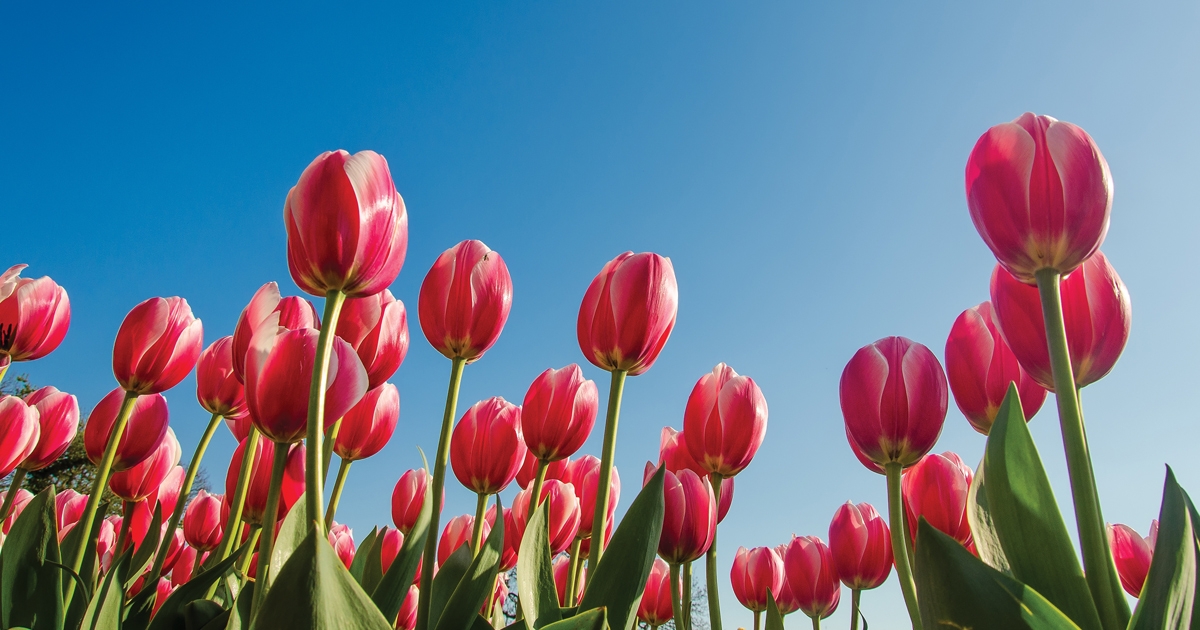Several years ago, I visited the Netherlands in the spring mainly because I wanted to see the Keukenhof Garden where daffodils, hyacinths, and tulips bloom in many different flower garden configurations. On 70 acres, more than seven million bulbs burst forth in bloom each year. Seeing this garden made me a forever lover of tulips because they announce spring with such brilliance. I wanted to know more about tulips before I started making a garden of them for myself.
Around 1000 A.D. the Turks started domesticating tulips that grew wild in their fields. Big, showy blossoms weren’t available until the people of the Netherlands started cultivating and selling them. Over the years tulip varieties were improved. Cut flowers and bulbs became a big business. Today, the Dutch send flowers, especially tulips, all over the world.
Tulips come in every color except black. There is a tulip that looks black, but it is really a dark purple. During the Victorian era, sending a bouquet of a certain color of tulips sent a message. Red tulips sent a “declaration of love” while lavender tulips meant “loyalty.” Yellow tulips signaled “hopeless love,” and a variegated tulip sent the message of a “beautiful smile.” A pink tulip was a symbol of “caring” and “good wishes.” It was an appropriate color for family members. In that day, you would send white tulips when you wanted to apologize because they meant, “I’m sorry.”
In the years that the Dutch were becoming known for cultivating and selling tulips, rare tulips cost more than people had paid for their homes. The frenzy was almost like the “gold rush” in America. Everyone wanted a piece of the action. They sold their assets, so they could reap the benfits of this rare opportunity. Then a glut caused the “The Tulip Crash” of 1637. After that, the government placed restrictions on the tulip market.
Besides the brilliant and variegated colors, tulips are bred for different sizes, fringes, and ruffles. After two tulips are cross-bred, it might take as many as five years to determine whether the botanist has the a hybrid that is desired. As many as 3500 different hybridized tulips are grown in the Netherlands today.
Conversely, a living tulip museum has been developed so that the tulip gene pool has been preserved. Some of the flowers grown there date back to 1595.
The town of Aalsmeer has a daily flower auction. This auction is the opposite of those in our country. A clock starts at a high price and goes down. The first person to “buzz” and to stop the clock buys the flowers being sold. In addition to bulbs and cut flowers, tulips are purchased to put in candles and soaps. They are also sold in pots, so they can be “forced” to grow and bloom in a warm space any time. As many as 50,000 flower deals are made at the auction daily.
When you see rows of blooming tulips in the field, you will almost always see workers walking up and down the rows. I was told that if a tulip plant looks unhealthy or wilted, the disease that it has will spread through the field quickly.
The whole plant, including the bulb, is immediately pulled and destroyed to protect the rest of the field.
On my trip, I saw tulips blooming in fields that would be over a half-mile long. A section would be one color, and in another section, a different kind or color of tulip would be growing. The whole area would be a rainbow of color.
The tulips in the fields were almost as enjoyable to view as those planted in the manicured gardens.
In the Keukenhof Garden, tulip bulbs are planted in three layers, so the tulips will bloom at different times. The season lasts longer that way and brings additional visitors from mid-March until mid-May, instead of a few short weeks.
Tulips are among the easiest flowers to grow. Simply plant the bulbs in the fall, so the roots become established before the ground freezes. Plant them at the depth indicated in the instructions that come with the bulbs. Plant them in a well-drained place and in bunches of the same color to create a brilliant, intense appearance. Then wait for the gift of color in the spring.
I was so excited after seeing how the beautiful tulips were arranged in the Keukenhof Garden that I ordered over a hundred dollars’ worth of bulbs while I was there. They were shipped to me in the fall when they should be planted.
When the bulbs arrived, I painstakingly planted them out in front yard, so my neighbors could join me in enjoying the rich color of these unusual tulips.
In other words, I wanted to show off my Dutch tulips. But that was not to be.
As soon as the plants erupted, the deer that we have in our area spied them, and the plants were eaten level to the ground. I quickly learned that deer consume tulip plants like children feast on candy. I now enjoy others’ tulips. Or could this void in my gardening life be an excuse to take another trip to the Netherlands? MSN










